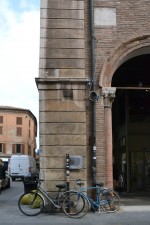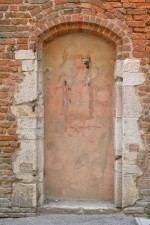The arrival of the French

The entry of the French into the city, on 23 June 1796, determined the "first emancipation" of the Jews of Ferrara.
1. The Jacobin three-year period
During the debate on the emancipation of French Jews, the deputy to the National Assembly Count of Clermont-Tonnerre says: "Everything must be rejected by the Jews as a nation, everything must be guaranteed to them as individuals". On 3 September 1791, the French National Assembly approved the Constitution, whose principles correspond to what is expressed in the Declaration of Human and Citizens' Rights of 26 August 1789, in which Art. 10 states: "No one should be harassed for their opinions, even religious ones, as long as the manifestation of them does not disturb the public order established by law". French enlightenment and revolutionary ideas therefore also reached Italy, especially during the so-called Jacobin three-year period (1796-1799) in which the French armies led by Napoleon Bonaparte (1769-1821) invaded the peninsula. The Jews were made free citizens in all respects and obtained their "first emancipation", considering the second that of the mid-nineteenth century.
2. The French Occupation
The transalpine troops, a company of a thousand soldiers under the command of General Robert, entered Ferrara on 23 June 1796, which became part of the Cispadana Republic first, then the Cisalpine, and finally the Italian Republic (1802-1805) and the Kingdom of Italy (1805-1814). At the elections of deputies to the Congress of Reggio Emilia on 21 December 1796, the ghetto separately elected a centurion. Evidently, however, the times are not yet ripe if, on 12 February 1797, riots arise between Christians and Jews after some Jews had dared to enter the Cathedral, and moreover with their hats on their heads. Commander Yann placed a cannon on the square of San Crispino and the revolt is averted. The new Republican government immediately worked to remove the gates of the ghetto that since 1627 had locked the Jews every day at sunset: in April 1797, Commander Latour ordered all the doors to be demolished, including those with monumental arches on Piazza San Crispino and Via Saraceno. The Jews also entered the city government: in 1798 Angelo Pace Pesaro was appointed president of the Municipality, Samuele Della Vida juniore, Abramo Bianchini seniore; in the Civil Guard there are three Jewish captains, three lieutenants and three second lieutenants; since 1799 Moisè Coen has been administrator of the municipality. In Lugo, Moisè Finzi became one of the five members of the municipal representation on 19 March 1799.
3. The arrival of the Austrians
On 11 April 1799, however, the Austrians besieged Ferrara and on 22 May the French had to withdraw from the city: "once the matter became known to the public, the lowly people began to tumult and threaten the neighbourhood inhabited by the Jews, but they were held back by the French troops, who did not withdraw to the citadel until midnight. When at dawn on the 23rd the main bell of this Cathedral was heard as a sign of the entry of the Austrians, a serious danger began for the Jews. Everything was arranged to attack their town and indeed in some houses the low people had already penetrated, when a picket of Austrian cavalry appeared in the Ghetto and its presence was enough to flee the invaders, so writes the Pesaro" (Magrini 2015, pp. 238-239).
On 26 May 1799, the Austrian general Klenau forbade Jews to leave the ghetto, also to protect them, and imposed a contribution of 50,000 shields to the Community.
4. The French Reconquest and the Restoration
On 14 June 1800, the French victory at Marengo returned Italy to the Transalpini; on 19 January 1801, Ferrara entered the Cisalpine Republic. The new republican government imposes on the Community a taxation as exorbitant as the Austrian one; at the Convention of Lyon of 26 January 1802, in which the Cisalpine Republic becomes an Italian Republic, three Ferrara Jews participate representing the merchants of the lower Po: Samuel Dalla Vida, Salvador Anau, Pellegrino Bianchini.
On 28 January 1814, the French government in Ferrara fell; the Austrians immediately had the gates of the ghetto replaced. The occupation of Ferrara by Gioacchino Murat (1767-1815) on 7 April 1815 restored and rekindled liberal hopes; on the 13th, however, the Austrians returned definitively, arresting the Jewish republican leaders Abramo Bianchini and Luigi Mareschi. When they were freed by the troops of Pope Pius VII (1742-1823), who regained possession of Ferrara on 18 July 1815, by concession of the Austrians, the fact unleashed the indignant reaction of the plebs through defamatory libels. The gates of the ghetto were reopened during the riots of 1831.
5. Quotes
"Occupied Ferrara in 1796 by the French army, the Republican government had rushed to remove the gates that closed the Jewish fence until the splendid period of the Este dynasty had been succeeded by papal domination [...]". (Leone Ravenna, article in The Israelite Banner, March 1898)
"I report what Pesaro wrote about those years: In 1796, having penetrated the Peninsula on 23 June of the same year, French Republican troops, consisting of an Infantry and Cavalry Dragoons corps with a few pieces of artillery, under the command of Brigadier General Robert, occupied this city and fortress. The aforementioned Commander, upon receiving on the same day the gifts of the representatives of the City and of the various Corporations, when the members of the Jewish Deputation presented themselves to him, ordered the same, that the Ferrara Jews should immediately remove from their hats the orange sign carried until then, since there should be no demarcation between Jews and Catholics, and ordered that the doors of the Ghetto should be open at night for the convenience of all citizens. […]”. (Magrini 2015, p. 222)
Bibliography
Related places
Related Themes
Compiling entity
- Istituto di Storia Contemporanea di Ferrara
Author
- Edoardo Moretti


